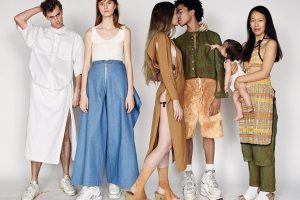In a world where trends change by the minute, the fashion industry has seen the rise of fast fashion. But with its intense production cycles and environmental impact, consumers are increasingly turning to slow fashion as an alternative. In this article, we explore the differences between fast fashion and slow fashion, discussing their respective implications for sustainability. By understanding these choices, individuals can make informed decisions to create a more sustainable wardrobe.
Fast Fashion: The Need for Speed Fast fashion refers to the rapid production and consumption of trendy clothing items, often at low prices. It is characterized by high-speed manufacturing, intensive marketing, and frequent turnover of collections. While it offers affordability and quick access to the latest styles, the fast fashion model comes with significant ecological and social costs.
Environmental Impact: The fast fashion industry is notorious for its negative environmental footprint. Rapid production processes consume immense amounts of water and energy resources, contribute to greenhouse gas emissions, and generate mountains of textile waste. Additionally, the use of synthetic fibers and harmful chemicals in production further pollutes waterways and harms ecosystems. Supporting fast fashion perpetuates this unsustainable cycle, exacerbating climate change and environmental degradation.
Ethical Concerns: The fast fashion industry often relies on exploitative labor practices, seeking cheap labor in countries with fewer regulations. Long working hours, low wages, unsafe working conditions, and a lack of worker protections are some of the issues prevalent in the fast fashion supply chains. Supporting slow fashion brands that prioritize fair trade practices and ethical sourcing contributes to a more humane and just fashion industry.
Slow Fashion: Mindful Consumption In contrast, slow fashion embraces a more conscious and sustainable approach to clothing production and consumption. It emphasizes quality, durability, and ethical considerations, encouraging consumers to make thoughtful and lasting choices.
Sustainable Materials: Slow fashion prioritizes the use of eco-friendly and sustainable materials. Natural fibers, organic cotton, recycled fabrics, and innovative alternatives like bamboo and hemp reduce the environmental impact associated with clothing production. Slow fashion brands also focus on using non-toxic dyes and reducing water consumption in their manufacturing processes.
Ethical Production: Slow fashion promotes transparency and accountability throughout the supply chain. It supports fair trade practices, ensuring that workers receive fair wages, safe working conditions, and access to basic human rights. By investing in slow fashion, consumers contribute to creating healthier and more equitable working environments.
Focus on Quality and Timelessness: Slow fashion encourages investment in high-quality, timeless pieces that withstand the test of time both in terms of durability and style relevance. Instead of chasing fleeting trends, slow fashion adopts a more minimalist and mindful approach to building a wardrobe, prioritizing versatility and longevity over fast turnover.
Supporting Local and Independent Brands: Slow fashion often involves supporting local artisans, independent designers, and small-scale producers who prioritize quality craftsmanship and promote responsible production practices. This supports local economies while reducing carbon emissions associated with long-distance transportation.
Conclusion: The choice between fast fashion and slow fashion reflects our commitment to sustainability and ethical consumerism. Understanding the impact of our clothing choices allows us to navigate the fashion industry more responsibly. By opting for slow fashion, we can make a positive impact by supporting sustainable materials, promoting ethical manufacturing practices, and embracing a more conscious approach to consumption. Together, we can drive change towards a more sustainable and equitable future for the fashion industry.














Add Comment